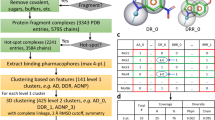Abstract
For the detection of the precise and unambiguous binding of fragments to a specific binding site on the target protein, we have developed a novel reporter displacement binding assay technology. The application of this technology for the fragment screening as well as the fragment evolution process with a specific modelling based design strategy is demonstrated for inhibitors of the protein kinase p38alpha. In a fragment screening approach seed fragments were identified which were then used to build compounds from the deep-pocket towards the hinge binding area of the protein kinase p38alpha based on a modelling approach. BIRB796 was used as a blueprint for the alignment of the fragments. The fragment evolution of these deep-pocket binding fragments towards the fully optimized inhibitor BIRB796 included the modulation of the residence time as well as the affinity. The goal of our study was to evaluate the robustness and efficiency of our novel fragment screening technology at high fragment concentrations, compare the screening data with biochemical activity data and to demonstrate the evolution of the hit fragments with fast kinetics, into slow kinetic inhibitors in an in silico approach.










Similar content being viewed by others
References
Congreve M, Chessari G, Tisi D, Woodhead AJ (2008) J Med Chem 51:3661–3680. doi:10.1021/jm8000373
Hann MM, Leach AR, Harper G (2001) J Chem Inf Comput Sci 41:856–864. doi:10.1021/ci000403i
Hann MM, Oprea TI (2004) Curr Opin Chem Biol 8:255–263. doi:10.1016/j.cbpa.2004.04.003
Sutherland JJ, Higgs RE, Watson I, Vieth M (2008) J Med Chem 51:2689–2700. doi:10.1021/jm701399f
Babaoglu K, Shoichet B (2006) Nat Chem Biol 2:720–723. doi:10.1038/nchembio831
Copeland RA, Pompliano DL, Meek TD (2007) Nat Rev Drug Discov 5:730–739. doi:10.1038/nrd2082
Swinney DC (2004) Nat Rev Drug Discov 3:801–808. doi:10.1038/nrd1500
Swinney DC (2006) Curr Top Med Chem 6:461–478. doi:10.2174/156802606776743093
Wood ER, Truesdale AT, McDonald OB (2004) Cancer Res 64:6652–6659. doi:10.1158/0008-5472.CAN-04-1168
Backes AC, Zech B, Felber B, Klebl B, Müller G (2008) Expert Opin Drug Discov 3:1409–1425. doi:10.1517/17460440802579975
Backes AC, Zech B, Felber B, Klebl B, Müller G (2008) Expert Opin Drug Discov 3:1427–1449. doi:10.1517/17460440802580106
Pargellis C, Tong L, Churchill L, Cirillo PF, Gilmore T, Graham AG (2002) Nat Struct Biol 9:268–272. doi:10.1038/nsb770
Regan J, Pargellis CA, Cirillo PF, Gilmore T, Hickey ER, Peet GW (2003) Bioorg Med Chem Lett 13:3101–3104. doi:10.1016/S0960-894X(03)00656-5
Frembgen-Kesner T, Elcock AH (2006) J Mol Biol 359:202–214. doi:10.1016/j.jmb.2006.03.021
Gill AL, Frederickson M, Cleasby A, Woodhead SJ, Carr MG, Woodhead AJ, Walker MT, Congreve MS, Devine LA, Tisi D, O’Reilly M, Seavers LC, Davis DJ, Curry J, Anthony R, Padova A, Murray CW, Carr RA, Jhoti H (2005) J Med Chem 48:414–426. doi:10.1021/jm049575n
Dauber-Osguthorpe P, Roberts VA, Osguthorpe DJ, Wolff J, Genest M, Hagler MT (1988) Protein Struct Funct Genet 4:31. doi:10.1002/prot.340040106
Cheng Y-C, Prusoff WH (1973) Biochem Pharmacol 22:3099–3108. doi:10.1016/0006-2952(73)90196-2
Zaman GJ, van der Lee MM, Kok JJ, Nelissen RL, Loomans EE (2006) Assay Drug Dev Technol 4(4):411–420
Acknowledgments
We are grateful to Stephanie Gspurning and Birgit Flicke for excellent technical assistance.
Author information
Authors and Affiliations
Corresponding author
Rights and permissions
About this article
Cite this article
Neumann, L., Ritscher, A., Müller, G. et al. Fragment-based lead generation: identification of seed fragments by a highly efficient fragment screening technology. J Comput Aided Mol Des 23, 501–511 (2009). https://doi.org/10.1007/s10822-009-9288-x
Received:
Accepted:
Published:
Issue Date:
DOI: https://doi.org/10.1007/s10822-009-9288-x




